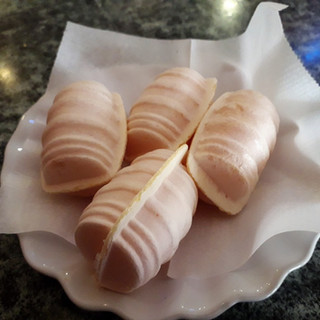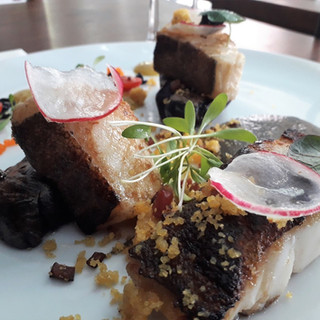Aveiro - fish, salt and sweet eggs
- Vedran Obućina
- Oct 31, 2018
- 6 min read
Updated: Oct 29, 2021

Along the Atlantic coast lies the Beira Litoral that is usually filled with tourists who like to surf and sunbath on miles and miles of sandy beaches. While Coimbra is a sophisticated university town in this area, on everyone’s mind come seaside resort towns such as Figueira da Foz, but Aveiro stands out and is well worth of a visit, for sightseeing and for gastronomy.
Aveiro is quite a feast for the eyes. It has a very distinctive youthful and energetic buzz with its modern fashionable buildings and apartments as well as with the name of Venice of Portugal thanks to its high-prowed boats, humpbacked bridges and picturesque canals. To get the sense of the place, the best way is to board any of the traditional seaweed and salt harvesting boats that are now converted to tourist use. Their name is moliceiro and every company has the same price and the same route.

The moliceiro guides shout in Portuguese, English, German, Italian and any other language the guests might come from, usually in the same time while talking to other moliceiros passing by. The boat passes through the Canal Central and first enters the Canal das Piramides, called as such because two pyramid structures show boundaries of the town in front of a vast lagoon. This lagoon is a product of ferocious storm in the 1570s which blocked the mouth of the Rio Vouga and created marshes. You can enjoy today the Marinha da Troncalhada Ecomuseum, which is part of the Traditional Salt Route of the Atlantic, that binds salt-making sites in Portugal, Spain, France and the United Kingdom.

For centuries, the salt of Aveiro had national and international recognition. It was a method for food preservation, but also a privileged product in trade relations and a type of payment – that is why it was called the white gold. Many local families lived from production and export of salt to Central and Northern Europe, but also far beyond to Newfoundland, where it was used to preserve codfish. Salinas, or salt works, in Aveiro are known by the name Marinha. It consists of a set of tanks organised in three orders (storage – comedorias, evaporation – mandamento, and crystallisation – meios), through which the salty water flows, with the salt crystals forming at the last stage. Traditionally, a marinha is enclosed by a wall of torrāo, mud and clay. During the spring tides, with full and new moons, the marinha receives the sea water from one of the lagoon canals. It flows by gravity through several basins until it reaches the crystallisers where the salt is formed, or, as the locals say, where the salt is born – nasce o sal.

The salt is still today kept in the warehouses along the Canal de São Roque. When a passage was forged back to the sea in 1808, Aveiro was rich once more and dozens of art nouveau houses from this period still define the town’s old centre. They are indeed beautiful, even the ones that are not preserved in the best way. There are some ten Art Nouveau houses that are worth of taking pictures of and putting on your Instagram, but for those who are more into the style and architecture, a distinctiveness of Aveiro’s Art Nouveau is that these houses are combined with something very traditional Portuguese: azulejos. This is blue painted tin-glazed ceramic tilework very typical for Portugal. You can find them virtually anywhere: in churches, palaces and schools as well as in ordinary houses, restaurants, bars, even railway and subway stations. They have their artistic value, but were ones functional for temperature control in homes.
In Art Nouveau houses dotted along the Canal Central and Rua João Mendonça you will find the gastronomic pride of Aveiro: ovos moles. These eggy and sugary sweets are originally developed by local nuns (what a surprise!) and are popular nationwide. The mixture is put inside of small rice paper in nautical shapes, such as shells. It is sweet, with the flavour of egg yolk and sugar softened by the cooking process and has a creamy and thick consistency. You can order them by pieces but do not think of it as very light. For an adult with affinity for dessert, four or five pieces are top level.

There are documents showing that, in 1502, King Manuel I granted 10 “arrobas” of Madeira sugar per year to the Convent of Jesus in Aveiro for the manufacture of confectionary products in the convent. The Ovos Moles de Aveiro are furthermore mentioned in 1908 as a dessert dish for royalty. To really get a sense of this sweet head to the Oficina do Doce, part living museum and part cooking school, where this proudest culinary tradition of Aveiro is shown to the guests and where you can learn about the process first-hand. There are others who sell it, but to have a real treat just look for the Protected Geographical Indication stamp on the product.

Just next door is the Aveiro Museum in the Convent of Jesus, where you can admire the Mausoleum of Princess Saint Joana. She was daughter of King Afonso V who is buried in a beautiful Catedral de São Domingos. In 1472, 11 years after the convent was founded, Joana retired here and stayed inside until her death. The centrepiece of this museum is her tomb, a 17th century masterpiece of marble mosaic set in a lavish room with azulejos depicting her life.

Behind the Art Nouveau houses there is a large opening – it is the Largo da Praça do Peixe, or simply Fish market. As a seafaring nation, Portugal has a well-developed fish industry and amount of fish and seafood eaten here is a heaven for every pescatorian! Strangely enough, it is not the local fishes that are most popular, but bacalhau – cod. This fish of northern seas is ever present in Portugal, and it is said there are more than 365 ways to cook cod, one for every day of the year. Well, I found one recipe of cod that they don’t have – it is the cod paste; nevertheless, Portuguese cod may well be the best you will ever try in your life.
I have tried excellent cod in the quite upscale fish restaurant O Bairro, sitting conveniently opposite the fish market. With chic tables and talkative waiters, O Bairro is also known for young and innovative chefs whose work you can see through open bar. In matter of minutes, very fresh fish is served in front of the guest, accompanied by a very fine wine list. The menu at O Bairro is simple and short, just as it should be for a good restaurant. It starts with very nice local appetizers such as “the stew of our neighbourhood” and O Bairro’s version of traditional soup Caldo verde, which consists of potatoes, collard greens, olive oil and salt and is one of the beloved soups of Portuguese people. Then you may try beautifully made shrimps (camarão ao olho) and scallops (vieiras crocantes) and not to forget one of the staples of Portuguese maritime gastronomy, sardines (sardinha).
Indeed, sardines are so popular that you can find them anywhere in Portugal. And sardines are considered very, very seriously in Portugal! After all, the Portuguese consume, on average, 13 sardines per second. That means, tons and tons of sardines. In summer, when sardines abound, people simply grill them on the charcoal or cool them with roasted peppers salad and boiled potatoes into a meal called Caldeirada. Otherwise, they tin them in brine, vinaigrette, tomato sauce, virgin olive oil, lemon and thyme or in any other way possible. Sardine conserves may be simple in outlook, but the places where they are sold in the exquisite establishments, akin to the fishermen’s version of Swarovski.

Fish menu in O Bairro consists of simply five dishes, which are one better than other. The chef suggests a meal that simply translates as “The market lives in front” (O Mercado mora em frente), which is basically anything fresh from the fish market, served with crunchy vegetables, and seasoned with peppers and herbal oil. Beautiful chunks of cod are served with salted potatoes and green beans. These chunks come as fresh and as dried cod and the difference among them is such a pure evidence of the chef’s expertise. Risotto fans will be delighted with shrimp and lime risotto, creamy masterpiece of beautiful shrimps spiced up with some lime. Carnivorous shouldn’t cry away from O Bairro, as they can find a very nice meat menu, albeit it would be a shame not to dwell into seafood here. Not to say there are some modern twists of traditional Portuguese desserts to die for!
In other, more traditional seafood eateries, you might see the menu in fishtanks and often elbow your way through the hungry crowd, especially if you want to try the local eels (enguias) that are served fried, grilled or in a stew. Of course, the lagoon and Aveiro marshes are excellent places for eels and other beautiful creatures that end up in a pot.








































































